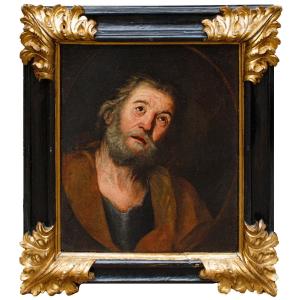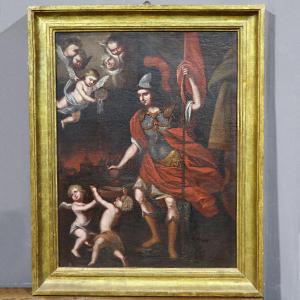Holy family with Saint John
Oil on canvas, 44.5x34 cm
With frame, cm 61 x 47
Prospero Fontana was born in Bologna in 1512: after a prolonged "practicum" as assistant to various Mannerist painters, first of all Perin del Vaga, with whom he collaborated in Genoa for the realization of the masterful cycle of frescoes in Palazzo Doria, Fontana opened a school in Bologna which played a significant role in the maturation of Emilian painting in the second half of the 16th century. Fontana was an excellent portrait painter (skill that he passed on to his daughter Lavinia, also a successful painter) and as such he was presented by Michelangelo to Julius III, becoming one of the favorite painters of the pontiff, who, as Lanzi «he was paid by the Pittor Palatine». For Julius III in Rome, Fontana was not only active as a portrait painter: he oversaw the decoration of the Belvedere in the Vatican, worked in Castel Sant'Angelo, decorated Villa Giulia together with Taddeo Zuccari and Pietro Venale, and frescoed the loggia of Palazzo Firenze in Campo Marzio (then belonging to the pope’s brother). Around 1560 he went to France: the artist is in fact one of the many Mannerist painters involved by the Primaticcio in what will be the foundation of the School of Fontainebleau, an experience that also proved very formative for Fontana. The French stay, however, was short, because Fontana, seriously ill, had to be repatriated in a hurry (not even managing to earn the advance received that Primaticcio then forgave him).Also around 1560, Fontana was commissioned by Cardinal Tiberio Crispo to decorate his palace in the city of Bolsena, now Palazzo del Drago. Shortly after, Fontana accompanied Vasari (with whom he had already collaborated in Rimini) to Florence, where he assisted him, together with Livio Agresti, in frescoing the Palazzo Vecchio (1563-1565), and where he was admitted to the Accademia Fiorentina del Disegno. He returned to Bologna in 1570, and the following year left for Città di Castello, where he was commissioned to decorate Palazzo Vitelli at Sant'Egidio. The work was undertaken, with help, from 1572 to 1574, but its central part, the 22 scenes of the Stories of the events of the Calves in the Hall, is often mentioned for the speed with which it was executed: it seems that the project, although absolutely splendid, was completed in a few weeks. From Città di Castello Fontana returned definitively to Bologna where, however, he had continuously operated in the intervals between the various trips. In 1550 he painted the Viola House with a cycle of scenes from the life of Constantine, in 1551 Palazzo Bocchi, between 1550 and 1556 Palazzo Poggi; in 1560 he painted the Dispute of Saint Catherine for the sanctuary of the Madonna del Baraccano, work particularly appreciated by his friend Giorgio Vasari, who praises him for his technical expertise in the Vines; between 1566 and 1568 he had decorated with fresco the chapel Pepoli in San Domenico and in 1570 he had participated in the decoration of the new apse in the Church of San Pietro. Fontana continued to paint until the '90s of the '500, although in the last part of his life he suffered strongly the competition of the newfound workshop of the cousins Carracci, active in the same period. This beautiful painting by the Bolognese painter’s workshop presents various references to the master’s work: as in the mobile works of Fontana’s production, also in this case it is denoted the fusion of Roman influences, Tuscany and Emilia: this is due to the numerous trips of the master in the Peninsula and his very close relations of friendship with figures such as Giorgio Vasari and Michelangelo. The theme of the Holy Family with San Giovannino is often revisited by Fontana in his works, as can be seen regarding the Holy Family with Saints Elizabeth and Giovannino of the civic museums of Vicenza - described by Mauro Lucco in these terms: "an image of serenity, to which adds charm the spring, cantabile shine of the colors in detachment, sometimes iridescent, certain of Vasarian origin, but not forgetful, once again, in the careful diluting light zones on darker areas, of what had been, and was, one of the secrets of Venetian painting" - or the Holy Family with San Giovannino and San Francesco of the civic museums of Forlì. The painting shows a domestic and peaceful atmosphere and a sense of sweet cohesion that shows how the student was able to brilliantly interpret and make his own solutions devised by his ideal master.






































 Le Magazine de PROANTIC
Le Magazine de PROANTIC TRÉSORS Magazine
TRÉSORS Magazine Rivista Artiquariato
Rivista Artiquariato